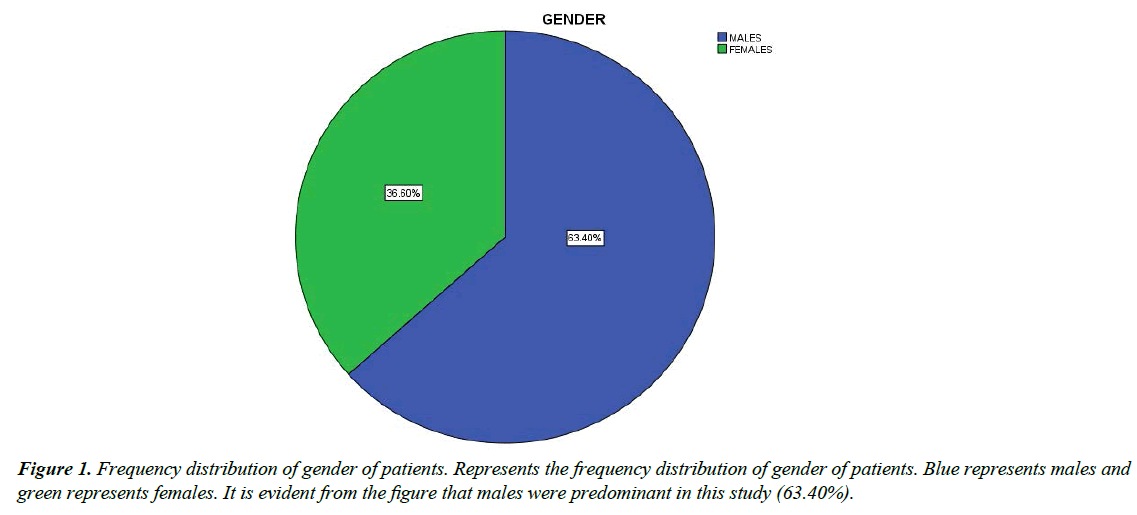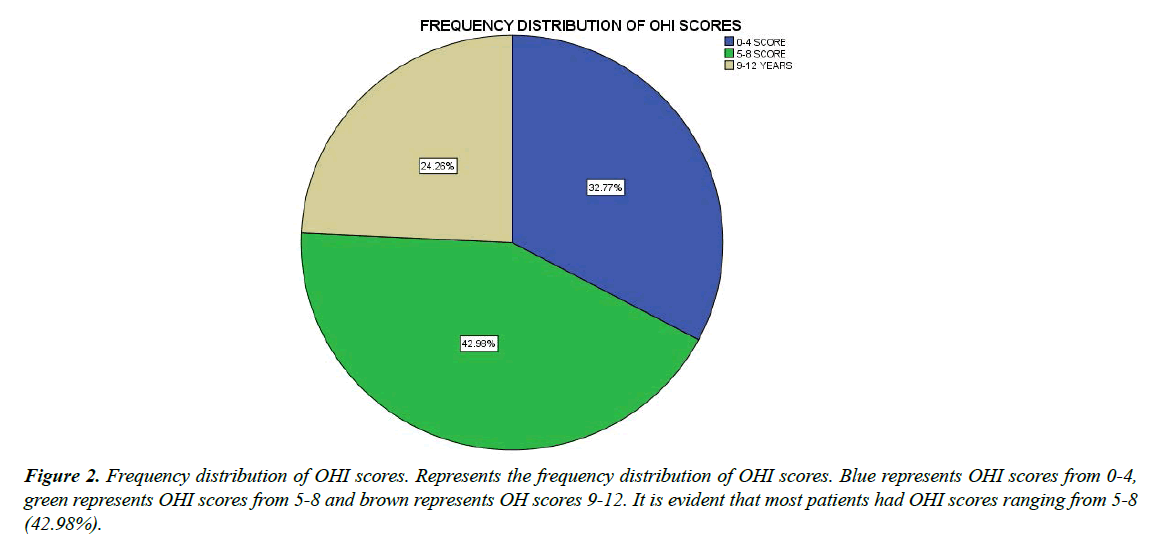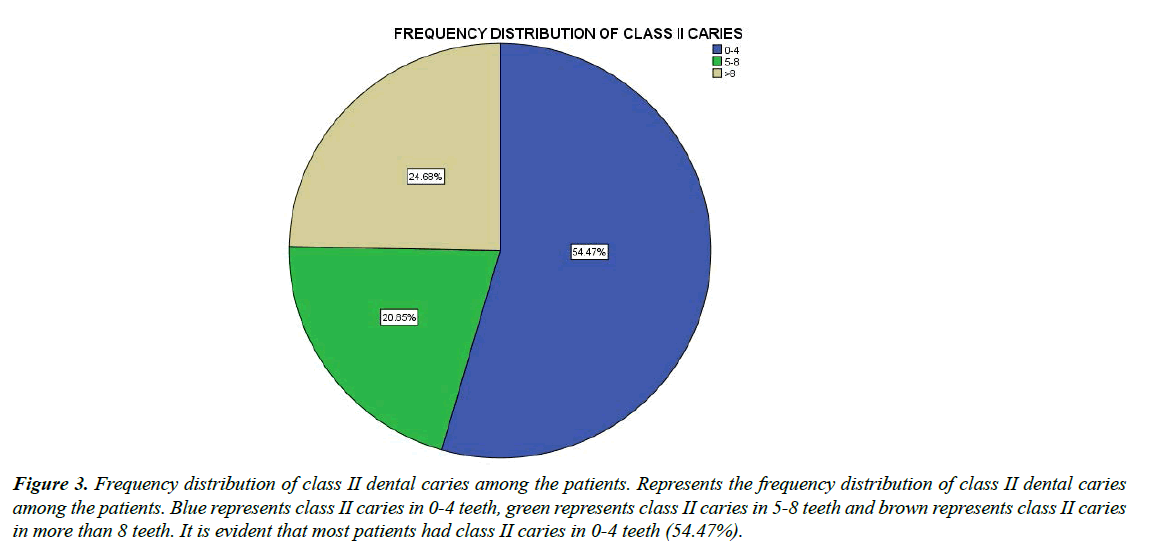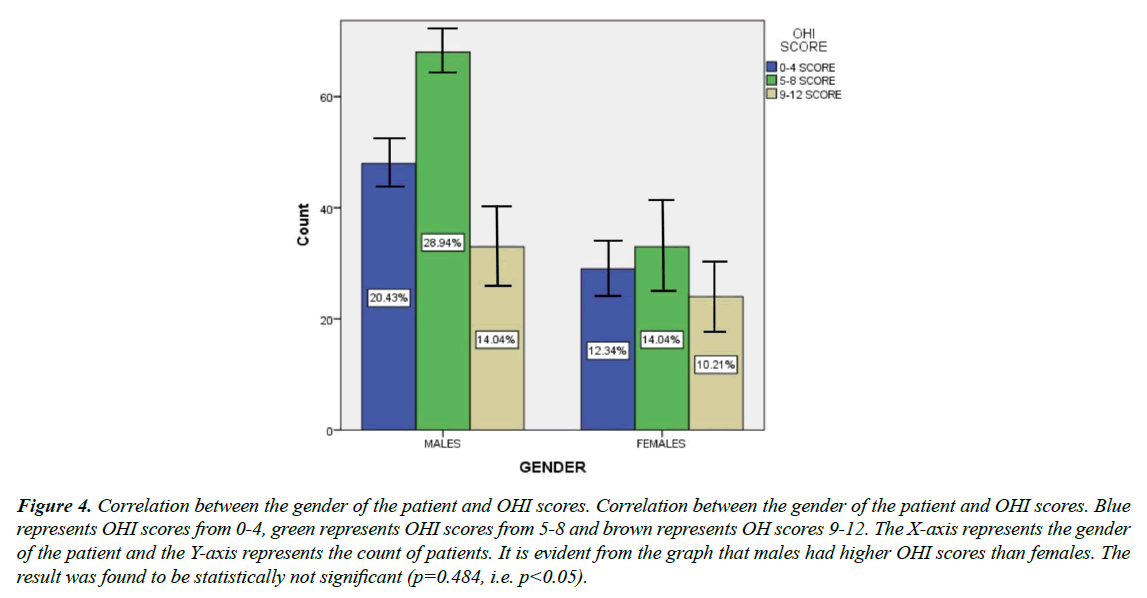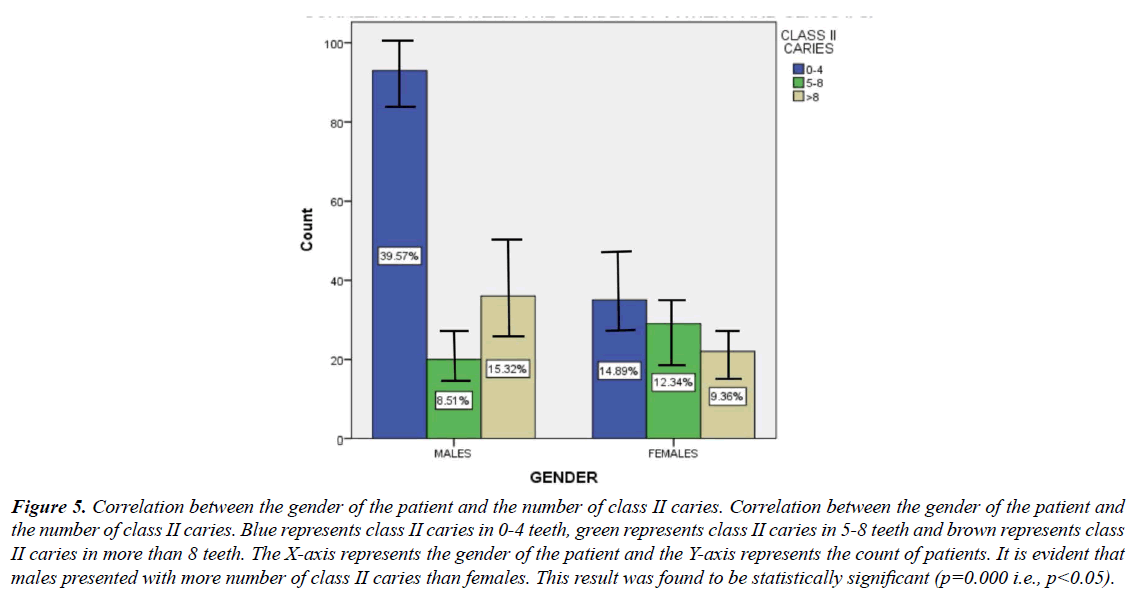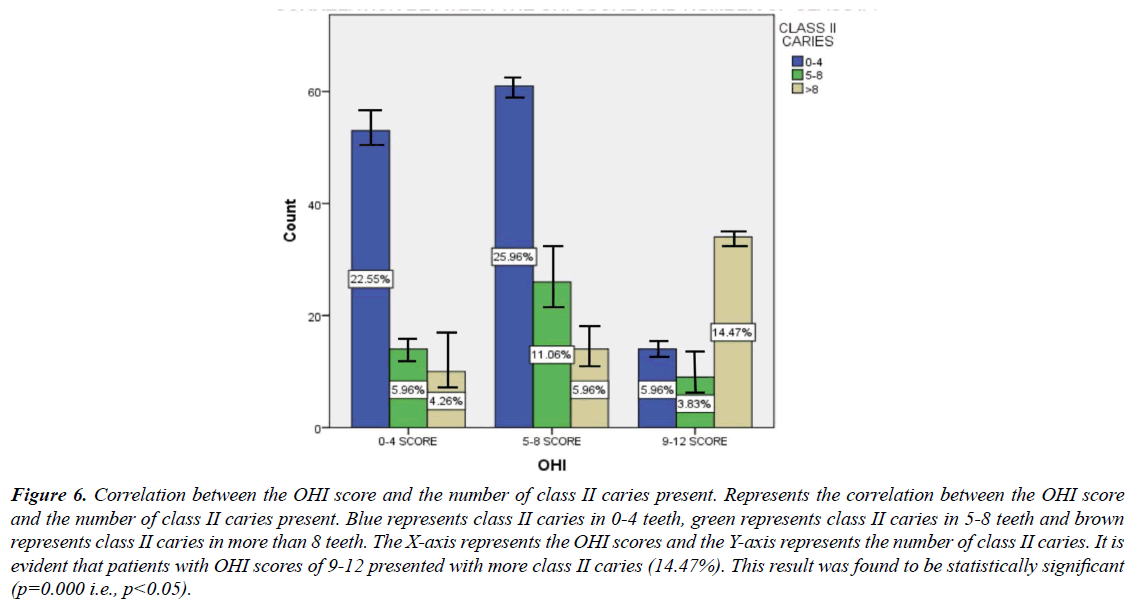Research Article - Journal of Clinical Dentistry and Oral Health (2022) Volume 6, Issue 6
CORRELATION BETWEEN OHI SCORES AND CLASS II DENTAL CARIES IN PATIENTS VISITING A PRIVATE DENTAL COLLEGE
Anjum S, Mahalakshmi J*Department of Conservative Dentistry and Endodontics, Saveetha Dental College and Hospitals, Saveetha Institute of Medical and Technical Sciences, Saveetha University, Chennai, India
- *Corresponding Author:
- Anjum S, Mahalakshmi J
Department of Conservative Dentistry and Endodontics
Saveetha Dental College and Hospitals
Saveetha Institute of Medical and Technical Sciences
Saveetha University, Chennai, India
E-mail: mahalakshmij.sdc@saveetha.com
Received: 18-October-2022, Manuscript No. AACDOH-22-80353; Editor assigned: 20-October-2022, PreQC No. AACDOH-22-80353(PQ); Reviewed: 04-November-2022, QC No. AACDOH-22-80353 (QC); Revised: 08-November-2022, Manuscript No. AACDOH-22-80353 (R); Published: 15-November-2022, DOI: 10.35841/aacdoh-6.6.127
Citation: Anjum S, Mahalakshmi J. Correlation between OHI scores and class II dental caries in patients visiting a private dental college. J Clinic Dent Oral Health. 2022;6(6):127
Abstract
Introduction: Dental caries is one of the most common preventable diseases which are recognized as the primary cause of oral pain and tooth loss. WHO claimed that poor oral health may have a profound effect on general health as well as quality of life, and several oral diseases are related to chronic diseases Aim: The aim of the current study is to correlate the OHI scores and class 2 dental caries. Materials and methods: This is a comparative and descriptive study which was performed under a university setting in the year 2021. The data of patients who visited dental college from December 2020 to March 2021 was collected by reviewing patient’s records and analyzing data. Patients with class II dental caries are considered in the study. The collected data was compiled , reviewed, tabulated and entered in SPSS software for running the chi square test to find if the correlations were statistically significant (p<0.05). Results and discussion: The study reveals that males had higher OHI scores and presented with more number of classes II caries than females than females. The former result was found to be statistically not significant (p=0.484, i.e. p<0.05) and the latter was found to be statistically significant (p=0.000 i.e., p<0.05). Patients with OHI scores of 9-12 presented with more class II caries (14.47%). This result was found to be statistically significant (p=0.000 i.e., p<0.05). Conclusion: The current study reveals that males had higher OHI scores and class 2 caries than females. The association between the OHI scores and the number of class 2 caries revealed that patients who presented with a high number of class 2 caries had high OHI scores.
Keywords
OHI, Class II dental caries, Innovative
Introduction
Oral disorders such as dental caries, periodontal diseases and tooth loss are critical public health issues around the world, given the fact that poor oral health has ill-effects on overall health and quality of life [1]. Plaque has to be present on a tooth surface to promote caries, but the relationship between oral hygiene and caries remains controversial. Clinical trials with self-performed oral hygiene programs have, however, not proved to be a successful way of preventing dental caries [2]. The relationship of caries prevalence to oral cleanliness, variation in brushing frequency, and oral hygiene level shows controversial results.
Dental caries is one of the most common preventable diseases which is recognized as the primary cause of oral pain and tooth loss. It is a major public health oral disease which hinders the achievement and maintenance of oral health in all age groups [3]. WHO pointed out that the global problem of oral disease still persists despite great improvements in the oral health of the population in several countries. WHO claimed that poor oral health may have a profound effect on general health as well as quality of life, and several oral diseases are related to chronic diseases [4]. Dental caries result when plaque forms on the surface of a tooth and converts the free sugars (all sugars added to foods by the manufacturer, cook, or consumer, plus sugars naturally present in honey, syrups, and fruit juices) contained in foods and drinks into acids that destroy the tooth over time. A continued high intake of free sugars, inadequate exposure to fluoride and a lack of removal of plaque by tooth brushing can lead to caries, pain and sometimes tooth loss and infection. This study provides knowledge on the association of OHI scores and the caries status of patients.
Our team has extensive knowledge and research experience that has translate into high quality publications [5-24]. The aim of the current study is to correlate the OHI scores and class 2 dental caries.
Materials and Methods
The current study was a comparative and retrospective study where the required data of the patients reported to the dental institution was collected by reviewing patient’s records and analyzing the data of all patients. The study was set in a University which predominantly consisted of the South Indian Population. The pros of the study were that it included a varied population and had the ability to perform preference analysis. The cons were that it had a very limited geographic area of coverage and small sample size. The ethical approval of the current study was obtained from the institutional ethical board. The selection of patients was from the list of out-patients, who visited the clinics from Dec 2020 to march 2021. The data was obtained for the Dental Information Archiving Software which is a database the total sample size obtained from the data was 236. The inclusion criteria were patients who presented with class II dental caries. Exclusion criteria were all incomplete and censored data. The data was cross verified using photographs and reviewed by an additional reviewer to minimize error. The data has high internal validity and low external validity. The data was entered in a methodical manner and was tabulated in Microsoft excel sheet. The tabulated data was imported to SPSS software (IBM) for statistical analysis (chi square test). Statistical significance was set at p<0.05.
Results
Figure 1 represents the frequency distribution of gender of patients. Blue represents males and green represents females. It is evident from the figure that males were predominant in this study (63.40%).
Figure 2 represents the frequency distribution of OHI scores. Blue represents OHI scores from 0-4, green represents OHI scores from 5-8 and brown represents OH scores 9-12. It is evident that most patients had OHI scores ranging from 5-8 (42.98%)
Figure 3 represents the frequency distribution of class II dental caries among the patients. Blue represents class II caries in 0-4 teeth, green represents class II caries in 5-8 teeth and brown represents class II caries in more than 8 teeth. It is evident that most patients had class II caries in 0-4 teeth (54.47%).
Figure 3: Frequency distribution of class II dental caries among the patients. Represents the frequency distribution of class II dental caries among the patients. Blue represents class II caries in 0-4 teeth, green represents class II caries in 5-8 teeth and brown represents class II caries in more than 8 teeth. It is evident that most patients had class II caries in 0-4 teeth (54.47%).
Figure 4 shows the correlation between the gender of the patient and OHI scores. Blue represents OHI scores from 0-4, green represents OHI scores from 5-8 and brown represents OH scores 9-12. The X-axis represents the gender of the patient and the Y-axis represents the count of patients. It is evident from the graph that males had higher OHI scores than females. The result was found to be statistically not significant (p=0.484, i.e., p<0.05).
Figure 4: Correlation between the gender of the patient and OHI scores. Correlation between the gender of the patient and OHI scores. Blue represents OHI scores from 0-4, green represents OHI scores from 5-8 and brown represents OH scores 9-12. The X-axis represents the gender of the patient and the Y-axis represents the count of patients. It is evident from the graph that males had higher OHI scores than females. The result was found to be statistically not significant (p=0.484, i.e. p<0.05).
Figure 5 shows the correlation between the gender of the patient and the number of class II caries. Blue represents class II caries in 0-4 teeth, green represents class II caries in 5-8 teeth and brown represents class II caries in more than 8 teeth. The X-axis represents the gender of the patient and the Y-axis represents the count of patients. It is evident that males presented with more number of class II caries than females. This result was found to be statistically significant (p=0.000 i.e., p<0.05).
Figure 5: Correlation between the gender of the patient and the number of class II caries. Correlation between the gender of the patient and the number of class II caries. Blue represents class II caries in 0-4 teeth, green represents class II caries in 5-8 teeth and brown represents class II caries in more than 8 teeth. The X-axis represents the gender of the patient and the Y-axis represents the count of patients. It is evident that males presented with more number of class II caries than females. This result was found to be statistically significant (p=0.000 i.e., p<0.05).
Figure 6 represents the correlation between the OHI score and the number of class II caries present. Blue represents class II caries in 0-4 teeth, green represents class II caries in 5-8 teeth and brown represents class II caries in more than 8 teeth. The X-axis represents the OHI scores and the Y-axis represents the number of class II caries. It is evident that patients with OHI scores of 9-12 presented with more class II caries (14.47%). This result was found to be statistically significant (p=0.000 i.e., p<0.05).
Figure 6: Correlation between the OHI score and the number of class II caries present. Represents the correlation between the OHI score and the number of class II caries present. Blue represents class II caries in 0-4 teeth, green represents class II caries in 5-8 teeth and brown represents class II caries in more than 8 teeth. The X-axis represents the OHI scores and the Y-axis represents the number of class II caries. It is evident that patients with OHI scores of 9-12 presented with more class II caries (14.47%). This result was found to be statistically significant (p=0.000 i.e., p<0.05).
Discussion
The results of the study showed that males have higher OHI scores than females (Figure 4). The correlation between the gender of the patient and the number of class 2 caries revealed that males have more number of class 2 caries than females (Figure 5). When the OHI score was correlated with the number of class 2 carries, it was found that patients having higher OHI scores had a higher number of class 2 carries (Figure 6).
A study conducted by Al Mohammed et al on Oral Hygiene status of children based on gender revealed that males had higher OHI scores than females. It is evident that males were found to have higher debri and calculus scores which led to the increased OHI score and hence the high amount of dental caries [25]. Similar results were obtained in several other studies which compared the OHI scores of children and adults [26,27]. Our study is in accordance with the above studies.
A study conducted by Genji, et al. on Association of age and gender distribution in patients having class II caries revealed that males had higher incidence of class 2 caries than females. The study also showed that the caries progressed to root canal treatment which explains the negligence and poor oral hygiene in males resulting in higher OHI scores [28]. The current study is in agreement with the above study.
Studies have identified the association between plaque and debris [29-31], accumulation and dental caries. However, Szyszka-Sommerfeld, et al. [32], reported that the influence of plaque accumulation on the development of dental caries and periodontal disease was minimal, and Vellappally, et al. [33] found no correlation between the plaque and food and dental caries among adolescents. Some researchers have reported that crowding causes improper contacts between neighboring teeth, making effective oral hygiene difficult. The difficulty with cleaning of crowded teeth increases plaque accumulation and predisposes to the development of dental caries and periodontal disease [34,35].
Conclusion
The current study reveals that males had higher OHI scores and class 2 caries than females. The association between the OHI scores and the number of class 2 caries revealed that patients who presented with a high number of class 2 caries had high OHI scores.
Acknowledgements
The authors would like to acknowledge the help and support rendered by The Department of Aesthetics Saveetha Dental College and Hospitals, Saveetha Institute of Medical and Technical Sciences, Saveetha University for the constant assistance with the research.
Funding
The present project is supported by Saveetha Dental College and Hospitals, Saveetha Institute of Medical and Technical Sciences, Saveetha University and A.I.Abu Dakar Dental Clinic, Chennai.
Conflict of interest
None declared.
References
- Noor SS. Chlorhexidine: Its properties and effects. J Pharm Technol. 2016;9(10):1755-60.
- Fure S. Five-year incidence of caries, salivary and microbial conditions in 60-, 70-and 80-year-old Swedish individuals. Caries Res. 1998;32(3):166-74.
- Hollander F, Dunning JM. A study by age and sex of the incidence of dental caries in over 12,000 persons. J Dent Res. 1939;18(1):43-60.
- Hicks J, Garcia-Godoy F, Flaitz C. Biological factors in dental caries: Role of saliva and dental plaque in the dynamic process of demineralization and remineralization (part 1). J Clin Pediatr Dent. 2004;28(1):47-52.
- Muthukrishnan L. Imminent antimicrobial bioink deploying cellulose, alginate, EPS and synthetic polymers for 3D bioprinting of tissue constructs. Carbohydr Polym. 2021;260:117774.
- PradeepKumar AR, Shemesh H, Nivedhitha MS, et al. Diagnosis of vertical root fractures by cone-beam computed tomography in root-filled teeth with confirmation by direct visualization: A systematic review and meta-analysis. J Endod. 2021;47(8):1198-214.
- Chakraborty T, Jamal RF, Battineni G, et al. A review of prolonged post-COVID-19 symptoms and their implications on dental management. Int J Environ Res Public Health. 2021;18(10):5131.
- Muthukrishnan L. Nanotechnology for cleaner leather production: A review. Environ Chem Letters. 2021;19(3):2527-49.
- Teja KV, Ramesh S. Is a filled lateral canal–A sign of superiority?. J Dent Sci. 2020 Dec;15(4):562.
- Narendran K, MS N, Sarvanan A. Synthesis, characterization, free radical scavenging and cytotoxic activities of phenylvilangin, a substituted dimer of embelin. Indian J Pharm Sci. 2020;82(5):909-12.
- Reddy P, Krithikadatta J, Srinivasan V, et al. Dental caries profile and associated risk factors among adolescent school children in an urban South-Indian city. Oral Health Prev Dent. 2020;18(1):379-86.
- Sawant K, Pawar AM, Banga KS, et al. Dentinal microcracks after root canal instrumentation using instruments manufactured with different NiTi alloys and the SAF system: A systematic review. Appl Sci. 2021;11(11):4984.
- Bhavikatti SK, Karobari MI, Zainuddin SL, et al. Investigating the antioxidant and cytocompatibility of Mimusops elengi Linn extract over human gingival fibroblast cells. Int J Environ Res Public Health. 2021;18(13):7162.
- Karobari MI, Basheer SN, Sayed FR, et al. An in vitro stereomicroscopic evaluation of bioactivity between Neo MTA Plus, Pro Root MTA, BIODENTINE & glass ionomer cement using dye penetration method. Materials. 2021;14(12):3159.
- Rohit Singh T, Ezhilarasan D. Ethanolic extract of Lagerstroemia speciosa (L.) Pers., induces apoptosis and cell cycle arrest in HepG2 cells. Nutr Cancer. 2020;72(1):146-56.
- Ezhilarasan D. MicroRNA interplay between hepatic stellate cell quiescence and activation. Eur J Pharmacol. 2020;885:173507.
- Romera A, Peredpaya S, Shparyk Y, et al. Bevacizumab biosimilar BEVZ92 versus reference bevacizumab in combination with FOLFOX or FOLFIRI as first-line treatment for metastatic colorectal cancer: A multicentre, open-label, randomised controlled trial. Lancet Gastroenterol Hepatol. 2018;3(12):845-55.
- Raj R K. β‐Sitosterol‐assisted silver nanoparticles activates Nrf2 and triggers mitochondrial apoptosis via oxidative stress in human hepatocellular cancer cell line. J Biomed Material Res Part A. 2020;108(9):1899-908.
- Vijayashree Priyadharsini J. In silico validation of the non‐antibiotic drugs acetaminophen and ibuprofen as antibacterial agents against red complex pathogens. J Periodontol. 2019;90(12):1441-48.
- Priyadharsini JV, Girija AS, Paramasivam A. In silico analysis of virulence genes in an emerging dental pathogen A. baumannii and related species. Arch Oral Biol. 2018;94:93-98.
- Uma Maheswari TN, Nivedhitha MS, Ramani P. Expression profile of salivary micro RNA-21 and 31 in oral potentially malignant disorders. Braz Oral Res. 2020;34.
- Gudipaneni RK, Alam MK, Patil SR, et al. Measurement of the maximum occlusal bite force and its relation to the caries spectrum of first permanent molars in early permanent dentition. J Clin Pediatr Dent. 2020;44(6):423-28.
- Chaturvedula BB, Muthukrishnan A, Bhuvaraghan A, et al. Dens invaginatus: A review and orthodontic implications. Br Dent J. 2021;230(6):345-50.
- Kanniah P, Radhamani J, Chelliah P, et al. Green synthesis of multifaceted silver nanoparticles using the flower extract of Aerva lanata and evaluation of its biological and environmental applications. Chem Select. 2020;5(7):2322-331.
- Al Nuaimi M, Ferguson DJ, Al-Mulla A. Oral hygiene status in school adolescents: A study of 20,000 school-age adolescents in 66 public and private schools comparing oral hygiene status by gender and ethnicity. South Asia. 2014;7781(37.3):14-6.
- Gábris K, Márton S, Madléna M. Prevalence of malocclusions in Hungarian adolescents. Eur J Orthod. 2006;28(5):467-70.
- Miller J. The relationship between malocclusion, oral cleanliness, gingival conditions and dental caries in school children. Br Dent J. 1961;111:43-52.
- Vertucci FJ. Root canal morphology of mandibular premolars. J Am Dent Assoc. 1978;97(1):47-50.
- Buczkowska-Radlinska J, Szyszka-Sommerfeld L, Wozniak K. Anterior tooth crowding and prevalence of dental caries in children in Szczecin, Poland. Community Dent Health. 2012;29(2):168-72.
- Hafez HS, Shaarawy SM, Al-Sakiti AA, et al. Dental crowding as a caries risk factor: A systematic review. Am J Orthod Dentofac Orthop. 2012;142(4):443-50.
- Caplin JL, Evans CA, Begole EA. The relationship between caries and malocclusion in Chinese migrant Workers' children in Shanghai. Chin J Dent Res. 2015;18(2):103-10.
- Szyszka-Sommerfeld L, Buczkowska-Radlińska J. Influence of tooth crowding on the prevalence of dental caries. A literature review. Ann Acad Med Stetin. 2010;56(2):85-88.
- Vellappally S, Gardens SJ, Al Kheraif AA, et al. The prevalence of malocclusion and its association with dental caries among 12-18-year-old disabled adolescents. BMC Oral Health. 2014;14(1):1-7.
- Feldens CA, dos Santos Dullius AI, Kramer PF, et al. Impact of malocclusion and dentofacial anomalies on the prevalence and severity of dental caries among adolescents. Angle Orthod. 2015;85(6):1027-34.
- Jones ML, Oliver RG. W and H Orthodontic Notes. Wright 2000.
Indexed at, Google Scholar, Cross Ref
Indexed at, Google Scholar, Cross Ref
Indexed at, Google Scholar, Cross Ref
Indexed at, Google Scholar, Cross Ref
Indexed at, Google Scholar, Cross Ref
Indexed at, Google Scholar, Cross Ref
Indexed at, Google Scholar, Cross Ref
Indexed at, Google Scholar, Cross Ref
Indexed at, Google Scholar, Cross Ref
Indexed at, Google Scholar, Cross Ref
Indexed at, Google Scholar, Cross Ref
Indexed at, Google Scholar, Cross Ref
Indexed at, Google Scholar, Cross Ref
Indexed at, Google Scholar, Cross Ref
Indexed at, Google Scholar, Cross Ref
Indexed at, Google Scholar, Cross Ref
Indexed at, Google Scholar, Cross Ref
Indexed at, Google Scholar, Cross Ref
Indexed at, Google Scholar, Cross Ref
Indexed at, Google Scholar, Cross Ref
Indexed at, Google Scholar, Cross Ref
Indexed at, Google Scholar, Cross Ref
Indexed at, Google Scholar, Cross Ref
Indexed at, Google Scholar, Cross Ref
